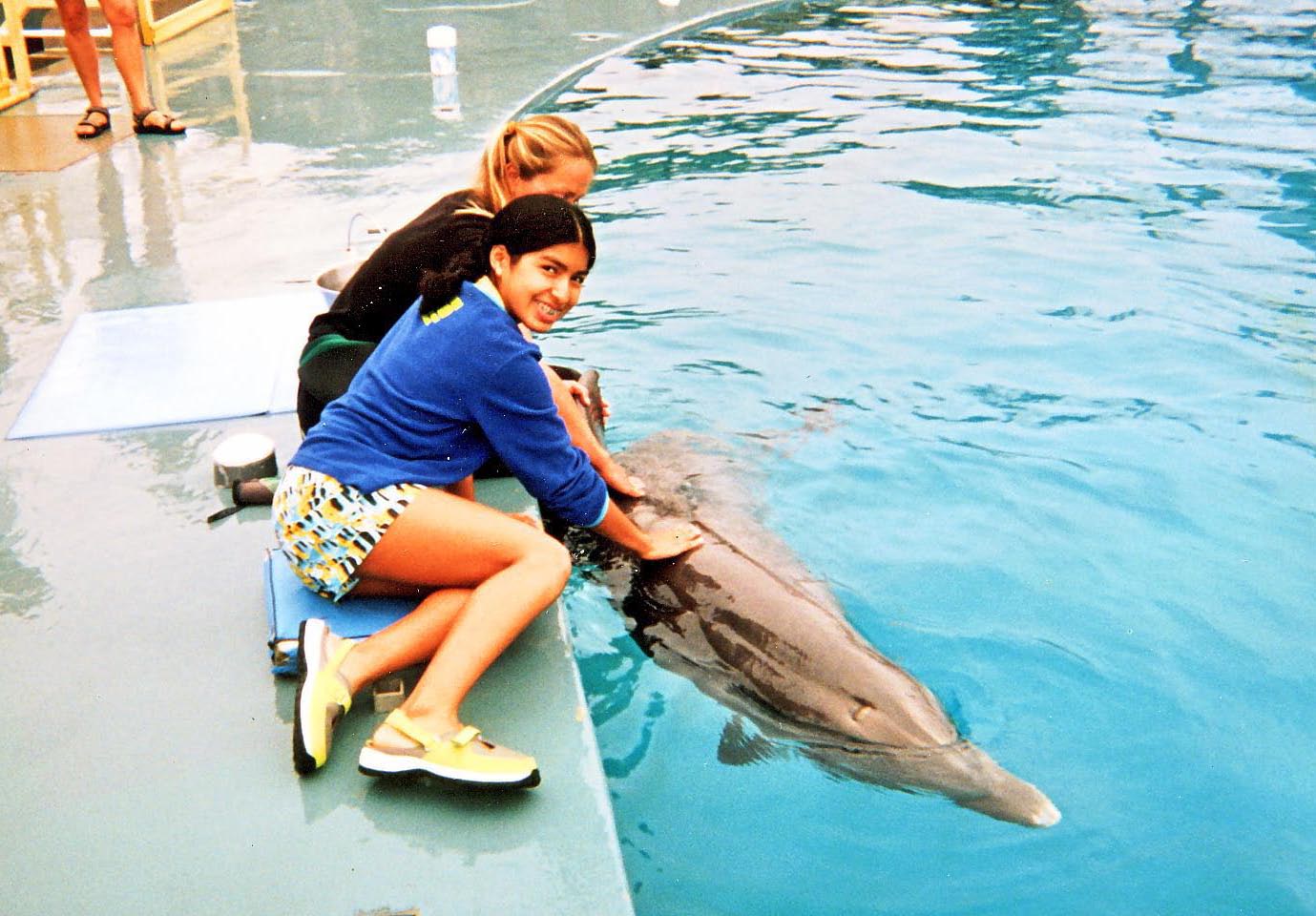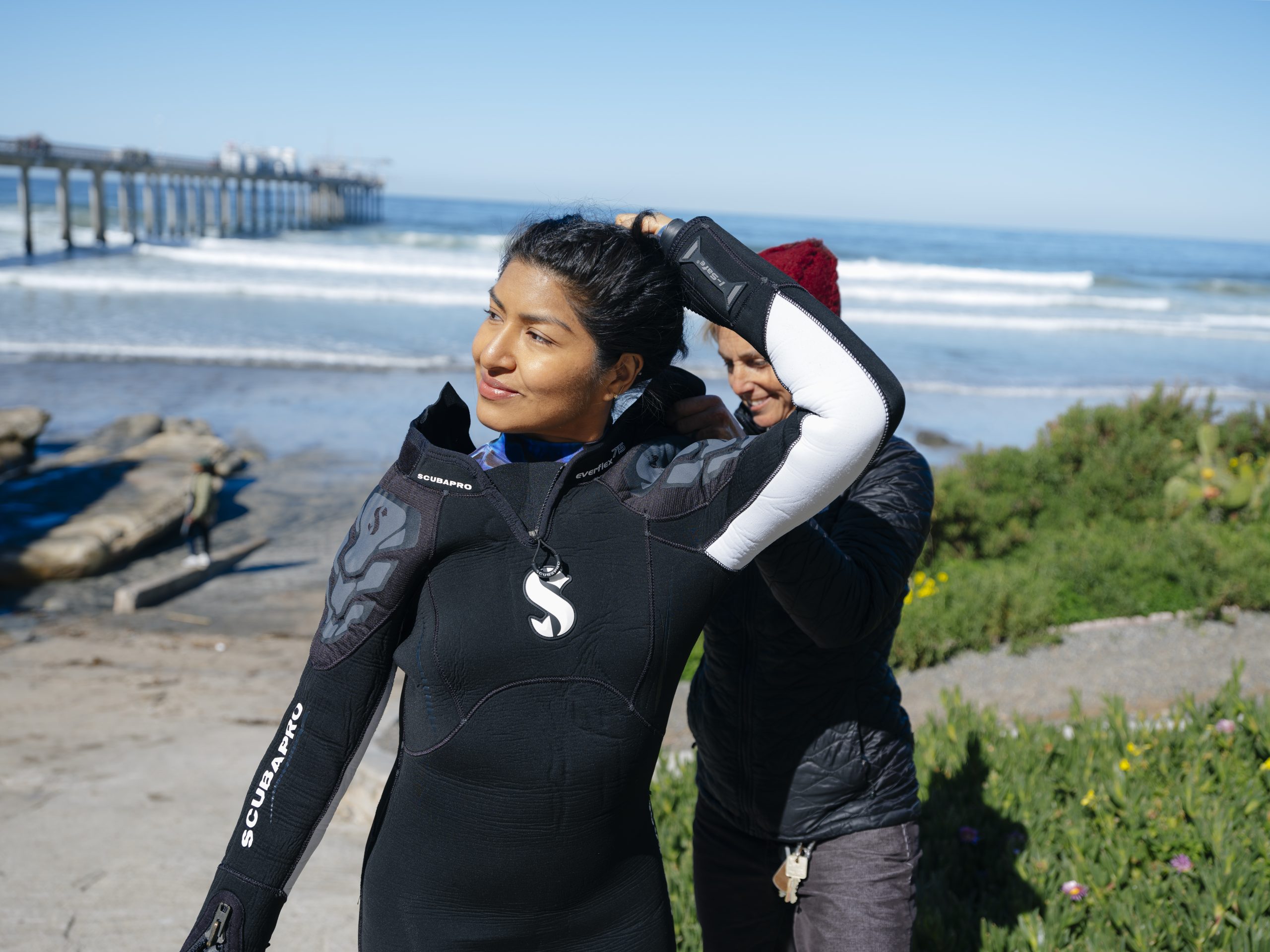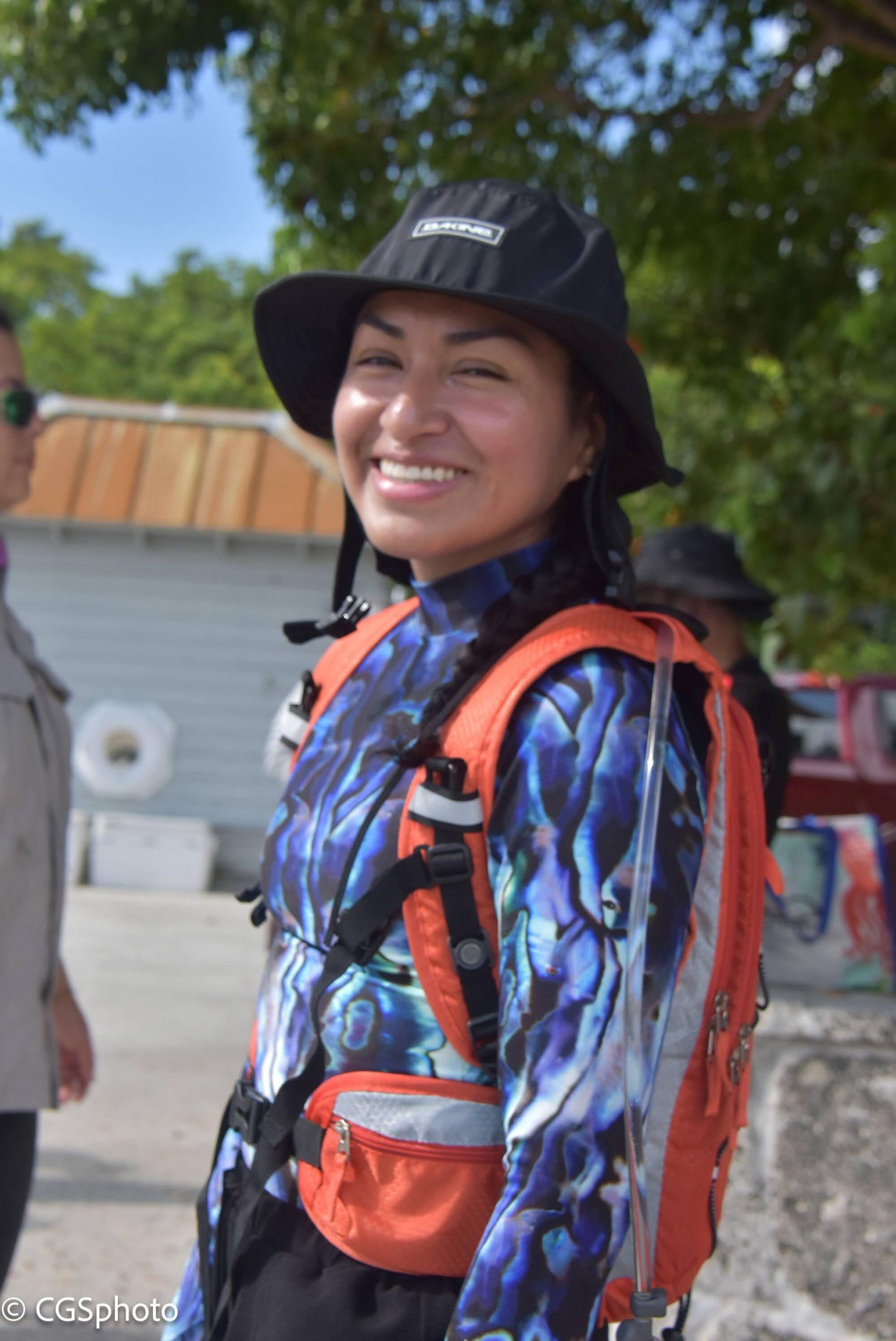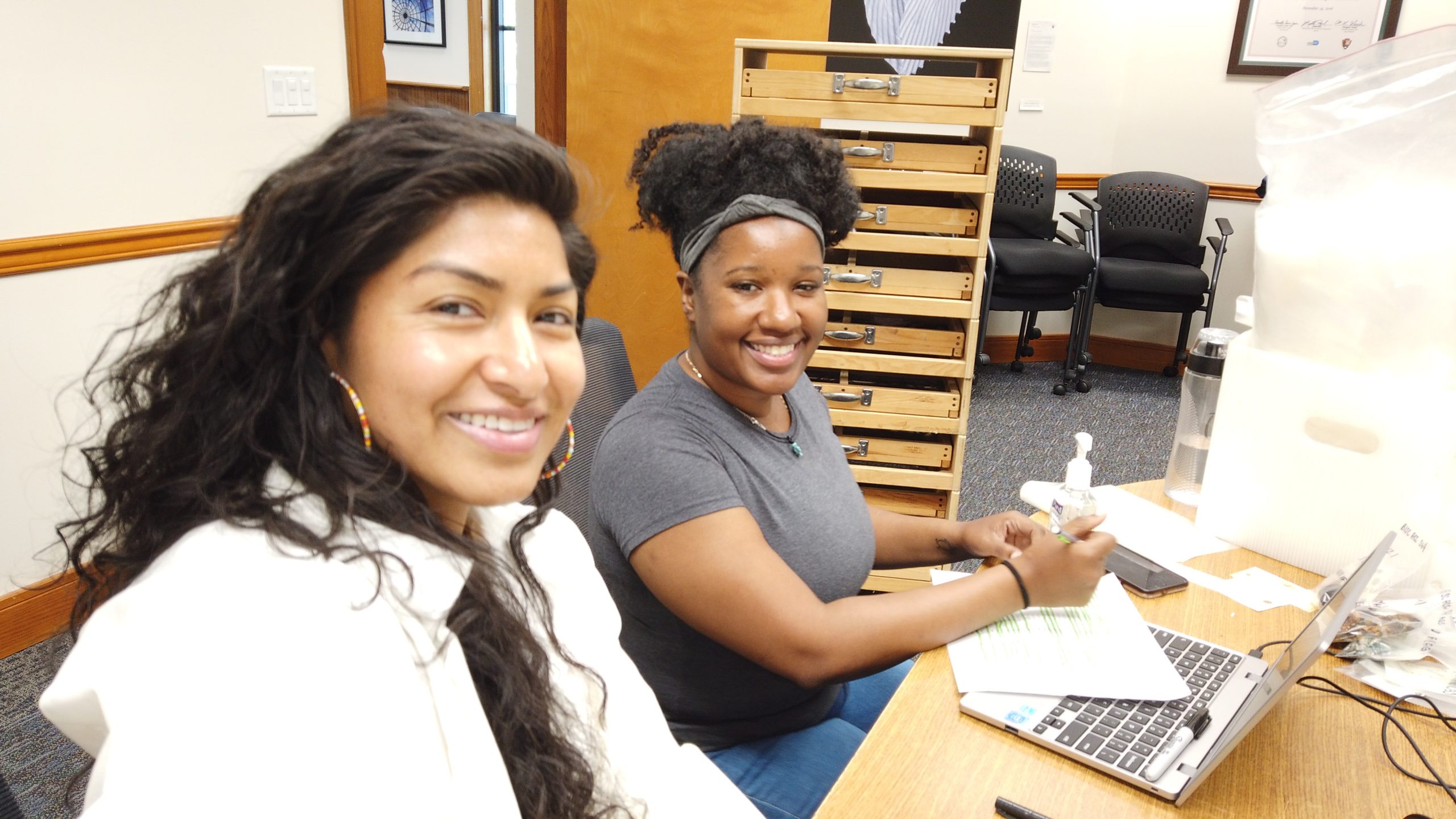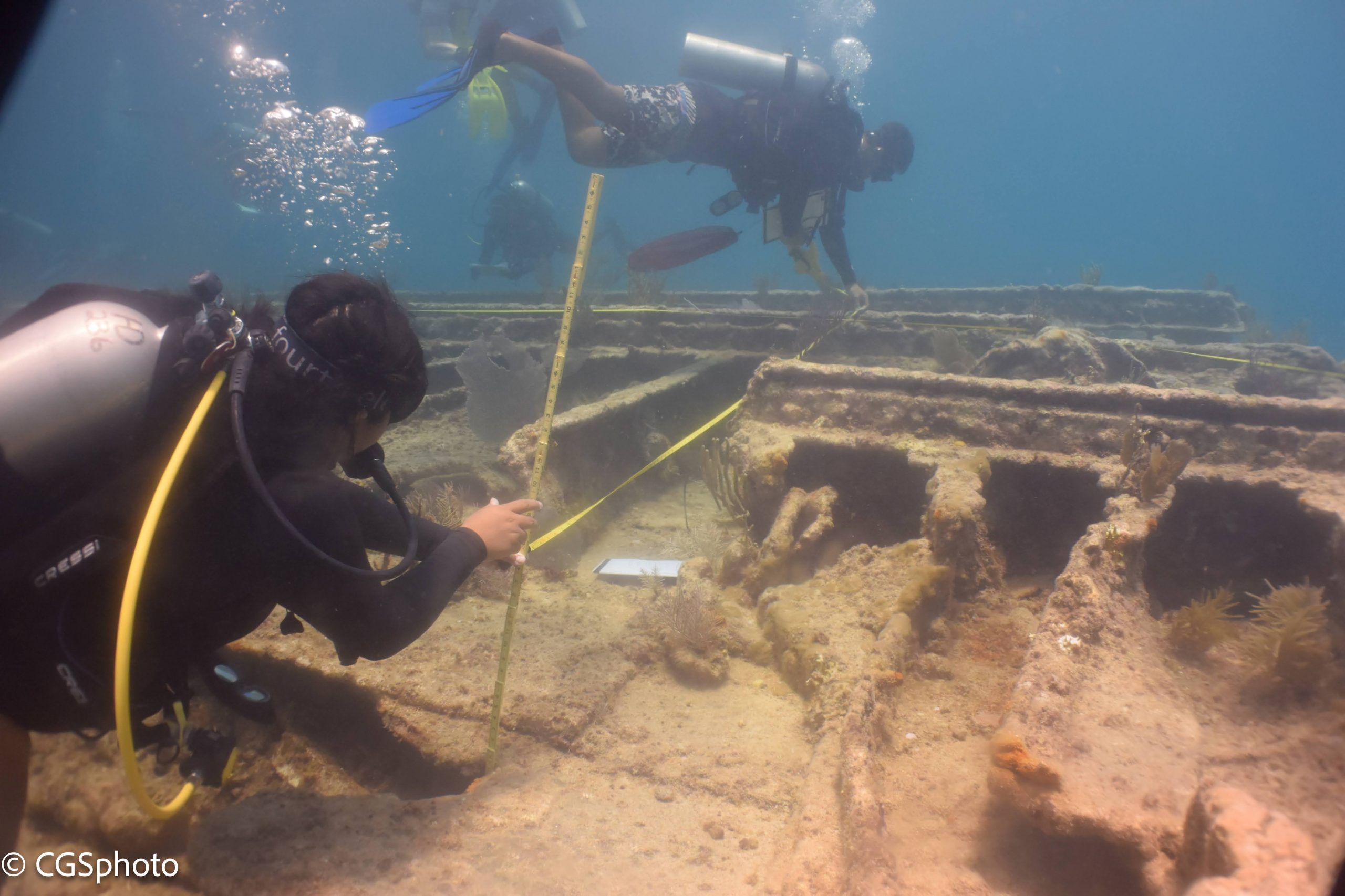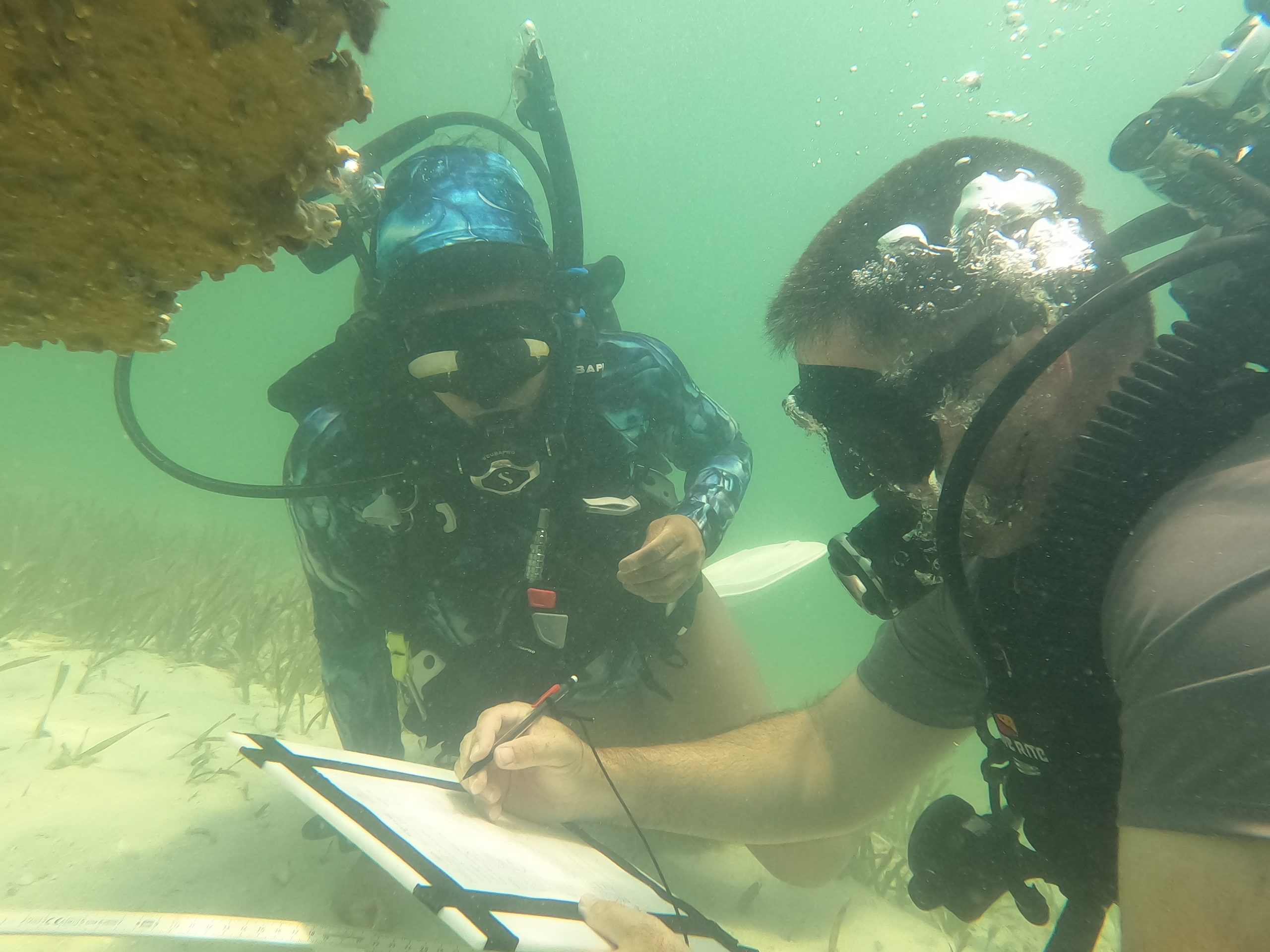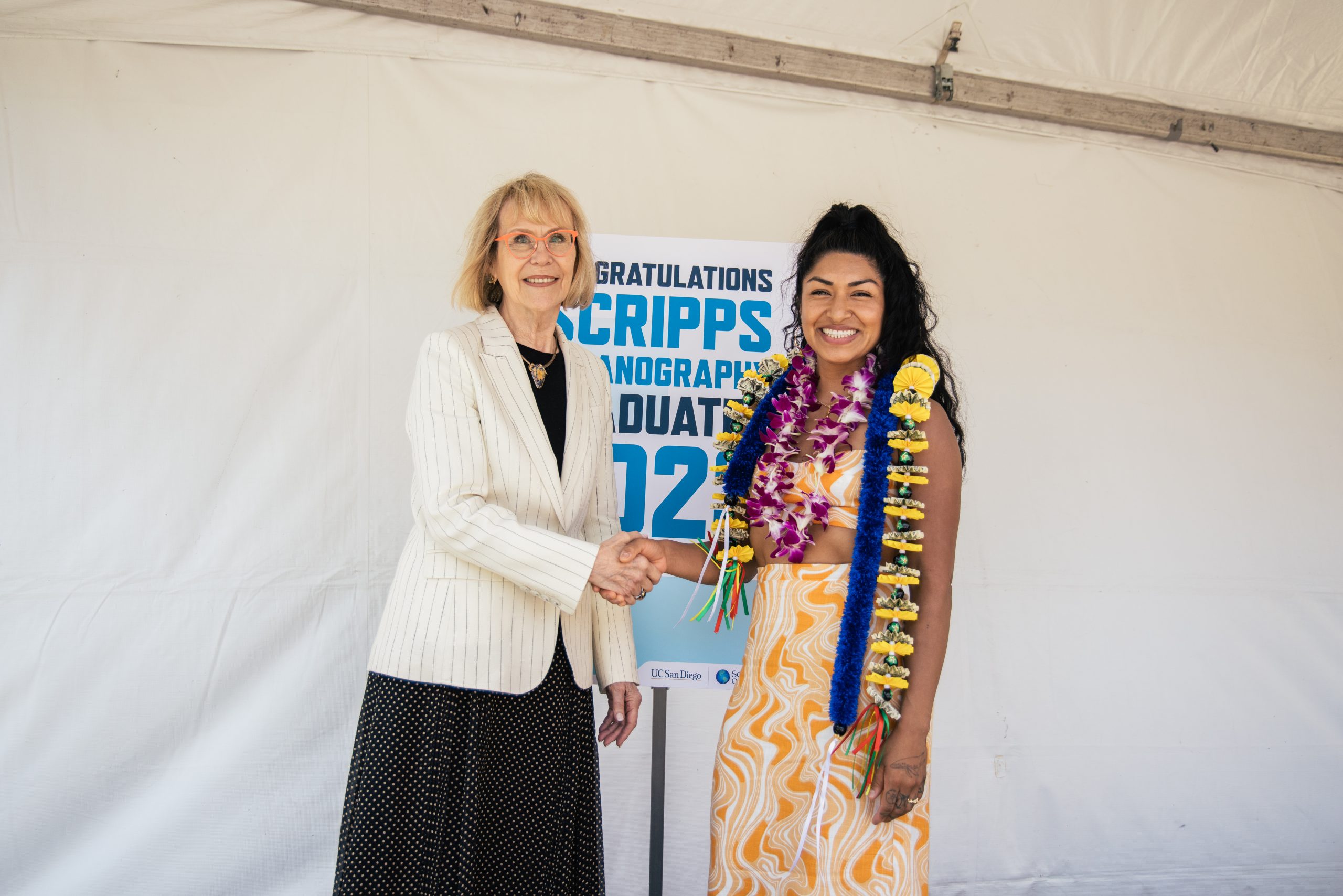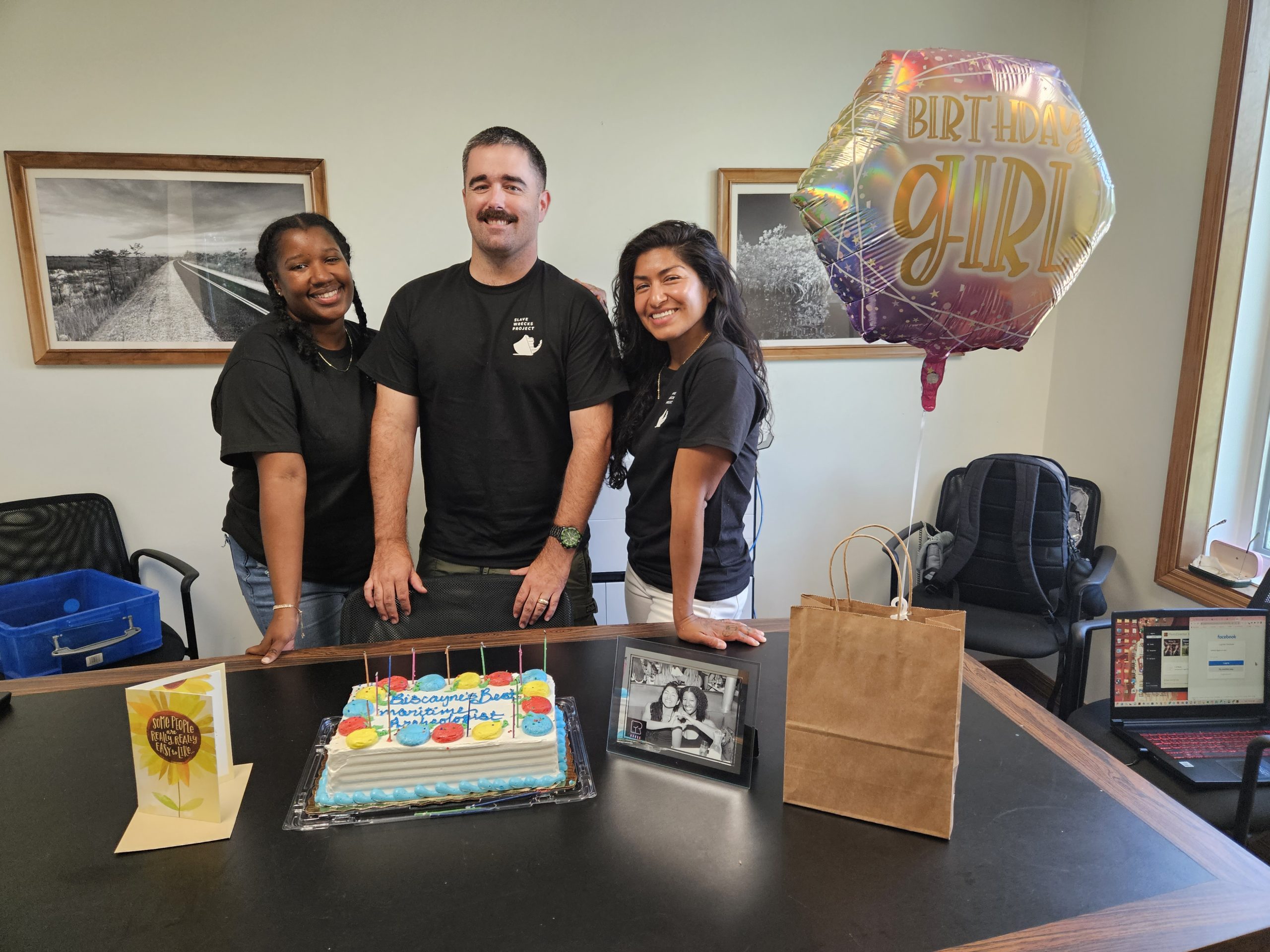SUMMARY
From Scripps Pier in La Jolla, California, to Elliot Key in South Florida, Analisa describes how getting into SCUBA showed her new niches in the ocean sector, opened a pathway into the world of maritime archaeology and cultural resource management, and how she leveraged the Master of Advanced Studies in Marine Biodiversity & Conservation (MAS MBC) program to get her first science diving gigs.
Getting to Scripps Institution of Oceanography
When I was 12, I spent a week at a marine science immersion summer camp hosted by University of California Santa Cruz’s Long Marine Lab and Seymour Discovery Center. After building a remotely operated vehicle (ROV) in a pool, exploring their scientific aquarium, and getting very up close and personal with some pinnipeds, I became absolutely sold on becoming a marine biologist.
But, I was raised in the Central Valley of California, hours away from the coast, and my local schools did not have any hands-on or academic marine programming. I left the dream behind, pursued other interests, and it wasn’t until 2018, over a decade later, that I started to seriously consider the possibility of a career in the marine sciences.
I leaned on my professional environmental networks, like the Environmental Leadership Program (ELP) and PGM (People of the Global Majority in the Outdoors, Nature, and Environment), searching out professionals with a marine academic or professional title who would talk to me about their work. I signed up for listservs like SEVENSEAS Media, started tuning into The Marine Mammal Science podcast, and signed up for virtual presentations being sent out by OCTO (Open Communications for the Ocean) to see what caught my interest. I knew there had to be multiple ways into the field, including putting a ton of time into volunteering hours from my home, and years getting a whole new bachelor’s degree in biology. I began looking at renowned graduate programs in the ocean sciences and took my first trip to visit Scripps Institution of Oceanography (SIO) with my mom in January 2020.
After browsing their faculty website, I was able to connect with researcher Aaron Thode, who kindly set up a meeting with me. We met in the beautiful Marine Ecosystem Sensing, Observation and Modeling (MESOM) building, and after hearing my very advocacy-focused background, he redirected me to the Master of Advanced Studies in Marine Biodiversity & Conservation (MAS MBC) program, which I hadn’t known about. Fortunately, the rest was history.
From Non Diver to Science Diver
I was accepted into the program, and decided that whatever niche I ended up focusing on, I definitely wanted to do something that would allow me to do fieldwork in some way. Although I had snorkeled before, I had never done any type of SCUBA diving. When I became aware of SIO’s historic Scientific Diving Program, it became my mission to meet all of their requirements so I could be trained by them. The first step was getting my open water certification. I talked to the owners of my local sustainable fish market, Ohana Seafood, and they directed me to our hometown dive shop, Aquatic Dreams. I was truly floored that my little town had a dive shop! And I was equally surprised when I was told the cost. Banking on a great return on investment, I signed up and a few weeks later took my first breaths underwater in the shallow end of their small indoor pool. I was at absolute peace.
Once in La Jolla at school, I tried to manage balancing the hectic MAS MBC summer program schedule with taking time for swims at the graduate housing pool and near the Scripps Memorial Pier to train for holding my breath, increasing my lap speed, and get comfortable swimming back and forth from the shore to the pier. During this time, I had learned about the Scripps SCUBA DIVERsity Fellowship Program. I was relieved that there might be some financial support and community for this pseudo sport endeavor that I had mainly seen mostly older white men do.
The first time I remember seeing divers of color was when I stumbled upon a National Geographic magazine featuring Diving With A Purpose on the cover at my uncle’s house. Not only did that article show me a totally different community of people who dived, I also learned that ships, wrecks, and human interactions with waterways was an actual area of study known as maritime archaeology. I was so moved by the anthropological and historical overlap with studying the ocean, and the roles that community members were playing in bringing often untold stories to light, that my new dream became supporting their work one day.
Introduction to Underwater Archaeology
As previously noted, the MAS MBC summer program is an exhausting several weeks. My class received presentations from almost 80 SIO faculty and other professionals about their expertise. It was a crash course in a multitude of ocean topics five days a week.
I was grateful for the exposure to so many fields though. The day that Dr. Isabel Rivera-Collazo visited our cohort, I was thrilled to learn about her directorship of the Scripps Center for Marine Archaeology. Her lecture provided guidelines about designing fieldwork in a non-extractive way, avoiding “parachute science”, and introduced a bigger picture effort in decolonizing science. This very much spoke to me as a trained community organizer and environmental justice advocate. When the Introduction to Marine Archaeology course became available, I registered immediately. Taught by PhD student and researcher Eric Rodriguez-Delgado and assisted by Jordan Griffin, the quarter was full of hands-on exercises, ranging from practicing blindfolded anomaly (or artifact) searches on land, to answering scenarios of ethical dilemmas in a class debate, to creating and presenting a scientific poster at the Birch Aquarium.
From queer ship culture to wave anatomy to thinking through application of various survey methods, I was hooked. Reading up on all of these topics was made much richer because by this time, I had been accepted into the DIVERsity Fellowship and had gone through the scientific diving program, developing a great rapport with other divers of color at SIO and my fellow trainees as well. Volunteering with them for the Bowman Lab, and Smith Lab PhD student Danielle McHaskell’s seaweed research, and the University of California San Diego Cultural Heritage Engineering Initiative helped break up hours at my laptop.
A Surprise Field Season in Biscayne National Park
I was in the depths of spring quarter when a WhatsApp message arrived on my phone. “Check your email!”, said Dr. Isabel. “You’ll want to see this.” It was an invitation to apply to a paid summer internship focused on maritime archaeology at Biscayne National Park with none other than Youth Diving With A Purpose and the Slave Wrecks Project. I dropped everything to apply, and was stunned to be chosen from a pool of more experienced international applicants hungry to be trained at the living classroom that is the nation’s largest marine park.
This internship, launched in 2020 by Biscayne National Park, Youth Diving With A Purpose, and the Slave Wrecks Project, had a goal to support minorities in the underwater archaeology field to gain experience from working professionals in the sector that they might otherwise not get due to the many financial and logistical barriers to getting on-the-ground opportunities. Students in the internship would get access to the living classroom of Biscayne where they could get well-versed in marine field operations both aquatic and terrestrial, improve scientific diving skills, and bring South Florida’s history alive. Given the lack of racial diversity in American archaeologists as well as SCUBA divers, the need for a stronger bridge that minority students scientists of color could use to enter the underwater archaeology field was paramount to fill a growing need for these professionals, particularly in cultural resource management.
I was housed within Everglades National Park with the other selected intern, Bria Brooks, a Masters student in Anthropology at the University of West Florida and Archaeology Assistant at the Florida Public Archaeology Network, and over the course of six weeks, quickly acclimated to the backcountry conditions of the region. Long lightning bolts and loud thunderstorms were a daily occurrence, which then broke into searing sunshine which demanded polarized sunglasses at all times, and included run-ins with various wildlife, most notably including being eaten alive by an aptly named bug called “no-see-ums”.
Almost every day we got alerts of heat advisories and record-high water temperatures,
and most days, we still drove to the Biscayne offices to motor around the park – sometimes because that was the only place we could get semi-stable internet. I wrapped myself in UPF clothing, filled up my water backpack, packed extra bottles of electrolyte water, and sprayed myself with the strongest bug spray and sunscreen that I could handle.
Bria and I were kept very busy, being immersed in the world of working for the national government, understanding the ways community science and academic research projects could be integrated, and observing the ways that international professionals and resources add to the worldview of the work. Bria and I, supervised directly by Josh Marano, Maritime Archaeologist for the South Florida Parks, had a whirlwind of a summer.
We assessed a long list of underwater resources at the Park, including site on the Maritime Heritage Trail, checked for compliance issues related to the National Historic Preservation Act (Section 106), practiced boat safety and handling skills, searched for anomalies using free diving, surface snorkeling, and SCUBA, carried out magnetometer surveys to verify past data and gather new sets, and cataloged previously conserved artifacts, all while constantly updating our field notebooks and learning about required site visit documentation forms. We worked closely with archaeologists from the Submerged Resources Center and the Southeast Florida Archaeological Center, and trained the YDWP leaders and participants in baseline offset.
It was a hugely unique opportunity to be surrounded by so many young people of color from all over the contiguous US, and even the Virgin Islands and Costa Rica, who were actually very seasoned divers despite their age. Many of them were returners to the YDWP program, and helped train those who were newer. One of the students this summer was actually doing her final open water dives to finish up and earn her open water certification. What a special community in which to do that! Another participant celebrated her birthday there. It was extremely impressive to hear their report backs about their efforts, and how seriously they took their search for evidence of the pirate slave ship Guerrero, a search that their sister program, Diving With A Purpose, had been collaborating on with Biscayne for over a decade. Earlier in the week, they had been discussing the history and purpose of Critical Race Theory, led by Jason Vasser-Elong, and were broadening their conversations to racial justice in all areas of their lives. They were encouraged to take on their role as primary narrators of history and document their experiences via creative writing exercises and blogs.
Another highlight of the summer was making a discovery that allowed Bria and I to start our own research project. During our second day of site assessments, Josh had spotted a turtle swimming away from our boat, which was not that uncommon, but he had also seen a white patch of sand underneath said turtle. This was a sign that the turtle had been visiting that site often and had cleared out the seagrass, potentially to rub itself on something. Was it something man made? We turned the boat around to get a closer look, and suddenly a ship’s anchor came into sight. After consulting with Josh and doing further primary and secondary research, we confirmed that the artifact turned out to be a remnant from a steamer ship called the St. Lucie that had wrecked off of Elliot Key during a massive storm on October 18, 1906. It had resulted in the largest documented loss of life in the park, with many victims being buried in the Miami City Cemetery. It was both thrilling and chilling to dive down, fan the sand with our hands, and see where the chain led away from the anchor, and think of what the many passengers on the ship experienced while fighting for their lives. We were honored to be able to bring the stories of these people to light.
The Next Field Season in Peru
While I hope to further my career in marine archaeology and cultural resource management, I also want to call myself a seasoned and “salty” science diver. I was born in Peru, studying there for a year of my undergraduate studies, and I always hoped I could return to live and work there one day. This motivated me to pursue a capstone project that would help me start a working relationship with a coastal community in the country.
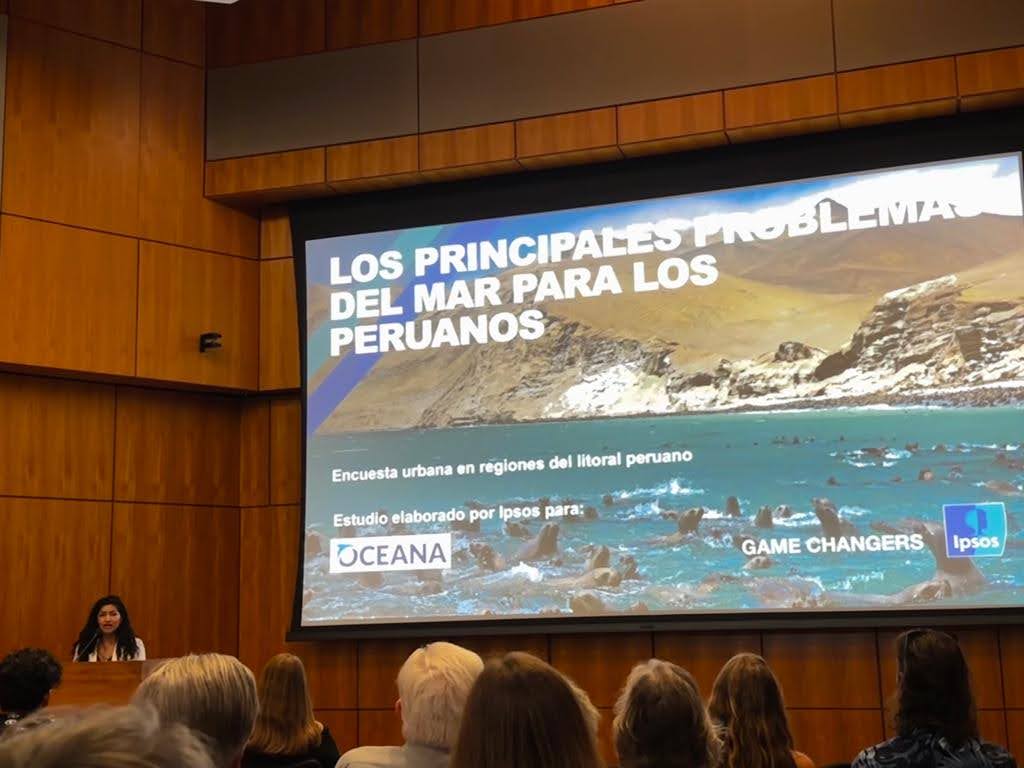 Supported by my incredible committee, including two MAS MBC alumni, I carried out a qualitative analysis of the challenges faced by locally-developed and -led marine conservation projects in Peru titled “Building All From the Small: Valuing Local Marine Conservation Projects in Peru”. In the process, Dr. Patricia Majluf, one of my committee members, had connected me to a PhD student at the University of British Columbia (UBC), Marta Flotats Aviles, who was collaborating locally in Peru with the international Project Seahorse. Shortly after my graduation, Marta followed up with me to ask me to be her dive buddy as a contract worker for UBC in 2024. I had to say yes! I am very ready for a side quest like this to further my scientific diving skills and contribute to baseline knowledge about seahorses in my birth country. Through the summer internship, I was also connected to another researcher, Alex Chavez Paredes, who is studying contemporary boat construction in Peru, so I hope to have time to get to know his work further while I’m in the country again.
Supported by my incredible committee, including two MAS MBC alumni, I carried out a qualitative analysis of the challenges faced by locally-developed and -led marine conservation projects in Peru titled “Building All From the Small: Valuing Local Marine Conservation Projects in Peru”. In the process, Dr. Patricia Majluf, one of my committee members, had connected me to a PhD student at the University of British Columbia (UBC), Marta Flotats Aviles, who was collaborating locally in Peru with the international Project Seahorse. Shortly after my graduation, Marta followed up with me to ask me to be her dive buddy as a contract worker for UBC in 2024. I had to say yes! I am very ready for a side quest like this to further my scientific diving skills and contribute to baseline knowledge about seahorses in my birth country. Through the summer internship, I was also connected to another researcher, Alex Chavez Paredes, who is studying contemporary boat construction in Peru, so I hope to have time to get to know his work further while I’m in the country again.
CONCLUSION
Opting for this graduate education program offered me a challenging yet rapid way to jumpstart my early ocean career. By tapping into all the resources that the program opened up to me, sharing my hopes with the experts around me, and trusting that there would be space for me somewhere in this sector if I just went for it, I was able to get the field experience I craved and narrow down my initially very broad interests in the marine world. I can’t wait to keep refining my focus and look back at this time as an incredibly special first chapter in my underwater story.
Read more about Diving with a Purpose and the impactful work Analisa did this summer here:
Archeologists discover anchor belonging to early 20th century shipwreck in Biscayne National Park
Archaeology: 19th-Century Steamship Anchor Found in Florida Waters
Wreck of Steamship Carrying “Builders of Miami” Found in Biscayne National Park
Anchor find comes with weighty history


